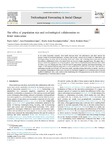The effect of population size and technological collaboration on firms' innovation

Use este enlace para citar
http://hdl.handle.net/2183/31767
Excepto si se señala otra cosa, la licencia del ítem se describe como Atribución-NoComercial-SinDerivadas 4.0
Colecciones
- Investigación (FEE) [923]
Metadatos
Mostrar el registro completo del ítemTítulo
The effect of population size and technological collaboration on firms' innovationFecha
2022Cita bibliográfica
Calvo, N., Fernández-López, S., Rodríguez-Gulías, M. J. & Rodeiro-Pazos, D. (2022). The effect of population size and technological collaboration on firms' innovation, Technological Forecasting and Social Change, 183 https://doi.org/10.1016/j.techfore.2022.121905.
Resumen
[Abstract]: In the current knowledge economy, firms hardly innovate alone; the collaboration with other partners has
become crucial for successful innovation. Literature has recently focused on two modes of collaboration: the
learning-by-doing, by-using and by-interacting (DUI) and science and technology-based innovation (STI).
Nevertheless, collaboration seems to be easier if firms are located in highly populated areas. This paper aims to
analyse whether the population size of municipalities where firms are located influences firm innovation either
in a direct way or by shaping the effect of the DUI and STI partnerships. Applying panel data methodology to a
sample of 3004 Spanish manufacturing firms over the period 2009 to 2016, the results show that innovative
performance benefits from STI and DUI innovation modes, especially product innovation. In contrast, location in
less populated municipalities seems to have no effect on innovation, regardless of the threshold used to limit the
number of inhabitants. Also, weak evidence of the moderating role of the population size on the effect of DUI and
STI partnerships on firm innovation is found.
Palabras clave
Product innovation
Process innovation
Population size
Technological collaboration
DUI learning mode
STI learning mode
Process innovation
Population size
Technological collaboration
DUI learning mode
STI learning mode
Versión del editor
Derechos
Atribución-NoComercial-SinDerivadas 4.0
ISSN
0040-1625






